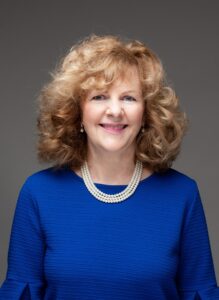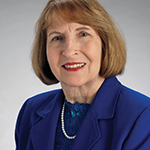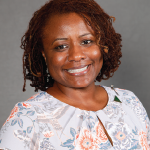Barbara Slusher, MSW, PA-C, describes herself as “eclectic,” a term that encompasses the varied personal and professional experiences she brings to her role as the new president of the ARP. Ms. Slusher holds a Master of Social Work from the University of Maryland, Baltimore, and studied to become a physician assistant at the University of North Texas, Fort Worth. She has developed curricula and taught courses, held positions in multiple medical specialties and is now an advanced practice provider supervisor at MD Anderson Cancer Center, Galveston and League City, Texas.

Ms. Slusher
Ms. Slusher will bring her varied experiences to bear as she heads the ARP this year and looks forward to focusing on volunteers, nurturing the relationship between the Rheumatology Research Foundation and the ARP, building more integrated healthcare teams and encouraging a holistic approach to healthcare. She took a few moments from her busy schedule to provide some insight into her perspectives, as well as her goals for the organization.
The Rheumatologist (TR): You started out your career in social work. What was your focus?
Ms. Slusher: My background is in substance abuse, and I worked with patients in a methadone maintenance clinic in Baltimore. That was back when we didn’t even know what human immunodeficiency virus (HIV) was, so that was an interesting time to work in substance abuse disorders.
From there, I moved to Texas to start medical school, but I ended up getting married instead and started working in an obstetrics and gynecology unit at the University of Texas Medical Branch (UTMB) in Galveston. I stayed there for several years, then moved to the employee assistance program, where I counseled employees on things like anger management and stress management. That job also introduced me to, and got me interested in, adult education.
TR: Once you became a physician assistant (PA), where did your career take you?
Ms. Slusher: I got a job offer to be a PA in interventional radiology at MD Anderson Cancer Center, and I took it. I didn’t even know what interventional radiology was at the time I accepted the job, but I was soon very grateful to have that opportunity because it gave me wide exposure to different types of cancers and a broad patient base, from adult men and women to the pediatric population.
Once I had my son, I decided to take a job that was closer to home and ended up as a PA in allergy and asthma, which also allowed me to work with every age, from infants all the way up to geriatric patients. I really enjoyed that experience, too.
TR: How did you start working in rheumatology?
Ms. Slusher: It was actually through a neighbor, who knew I was a PA. She had lupus and was very sick. I saw her from time to time, and at one point, she mentioned that she wished I would talk to her rheumatologist because he could really use some help at his office. I didn’t pursue it, but she brought it up a few times afterward, and I finally asked her for his card and said I would give him a call. I did.
I went into his office, even though I didn’t know much about rheumatology. I wanted to show him what a PA can do in an office and what types of patients we can see. One of the nurses I had worked with at the allergy clinic had actually worked for this rheumatologist, so she vouched for me and told him I would be a great addition. I ended up shadowing him for about four hours. It turned out that I really liked his patient population, so I became a PA in his office.
TR: Why have you stayed in rheumatology?
Ms. Slusher: It is a very good feeling as a provider to come in and be able to make a difference for a patient, and with the ushering in of biologics, we can help patients feel better in a very short period of time. I also enjoy the patient-education aspect in diseases ranging from gout to lupus to dermatomyositis and being able to really make patients into partners in their healthcare.
Now that I’ve been in rheumatology for several years, I find that this field is the perfect intersection of allergy, immunology and oncology. And since I get to provide education and use my social work skills quite a bit while seeing patients, I’d have to describe my eclectic background as ‘interprofessional.’ I’m very thankful for this path in my career.
TR: You have been an active volunteer in the ARP. Why did you get involved?
Ms. Slusher: I had just started my job as a PA in the rheumatologist’s office when I got a call from someone at the ARP. That person was Kim Kimpton, PT, who was the ARP president elect at the time. She said the ARP was developing a clinical focus course to teach nurse practitioners (NPs) and PAs how to do joint injections and physical exams, and she wanted me to help with the course development. I told her that she must have me confused with someone else, because I had just joined a rheumatology [practice] and really needed that course myself. She said the organization wanted my perspective as a new PA working in rheumatology. I have a volunteer spirit anyway, so she was able to talk me into it. That’s how I got started volunteering for the ARP.
It turned out that we were able to develop a fabulous course, called the Clinical Focus Course, that was hands on and on site, and included didactic education in the morning, followed by physical exams with real patients, and also provided practice on models for doing joint injections. It was a very in-depth, complex course, and we got such great feedback that we continued offering it for several years.
TR: How have you volunteered with the ARP since then?
Ms. Slusher: Most recently, I served on the ARP Practice Committee for a year, then chaired it for two years. In that committee, we created webinars introducing the concept of hiring an NP or PA into a rheumatology practice and explained why that would be a good thing for a rheumatologist to do. That was very interesting and a great experience as well.
I also was able to work on the Mentored Nurse Practitioner/Physician Assistant (NP/PA) Award for Workforce Expansion project, which we kicked off in 2019. It’s a Rheumatology Research Foundation-supported initiative that provides $25,000 for a practice that hires a new NP or PA. It took quite a bit of time to get that off the ground, but it’s been wildly successful, with 24 awards made so far.
TR: Has volunteering with the ARP benefited you personally?
Ms. Slusher: Oh yes. One of the reasons why it’s so important to volunteer is that you get to make relationships and friendships that maintain you throughout your career. For instance, I’m still great friends with Kori Dewing, ARNP, DNP, who was chair of the Clinical Focus Course Development task force at the time. A story within a story: She is now the ARP president-elect, set to take over after my term.
TR: Speaking of the ARP presidency, what are your top goals for the ARP in the coming year?
Ms. Slusher: I definitely want to make sure that our flagship courses are renewed. They are tremendous modular courses, so people can come in and take all the modules or just a few.
I also want to make sure that we focus on volunteers. Especially given the last two years we’ve gone through with the pandemic, we have found it harder to engage our volunteers. My focus is to find out more about our volunteers, how to encourage them and connect with them in this new virtual world, what their needs are and how to better integrate them into practices. I don’t believe there’s one particular answer, but I think we need to start taking a look at other models, including internationally, and finding out what our volunteers are capable of doing, what they’re doing in current practice and how we can pave the way to improve those efforts.
Finally, I want to foster a closer working relationship between the Foundation and the ARP, and continue joint efforts, such as the very successful Mentored NP/PA Award grant.
TR: What goals do you see beyond 2022?
Ms. Slusher: One thing that is very important is better integration of the healthcare team. We need to do more to grow the workforce, not only from the rheumatologist’s perspective, but also looking at services that pharmacists can provide in a rheumatology practice, what kinds of patients NPs and PAs can see and the roles that physical therapists or occupational therapists may play in a rheumatology practice.
That integration can extend beyond rheumatology as well, really to all members of the healthcare team. Telemedicine is going to play a big role in that process. We dragged our feet for 10 to 15 years in implementing telemedicine, but its time has come. For instance, we have a dearth of pediatric rheumatologists and of rheumatologists in rural areas. Telemedicine should be able to help us fill some of those gaps.
One other change I would like to see—perhaps because of my social work background—is more effort dedicated to patient education, particularly regarding prevention. Even in my own practice as a PA, I don’t spend much time talking to patients about preventive steps they can take, such as nutrition and lifestyle choices, and the impact those can have on their overall health and disease outcomes. I think the whole medical field, including we in rheumatology, need to look at patients from a more holistic perspective.
TR: On a lighter note, is there anything you’d like to share about yourself?
Ms. Slusher: I was raised on a small farm in Hanover, Md.—in fact, my dad still has a farm—and I have come to love … dairy goats! It’s been kind of a thing over the years. For instance, when I did some teaching in the PA program at UTMB, the students found out about it and would sometimes randomly include a photo of a goat in their presentations. It got very funny. The goats may be a bit weird, but like I said, I’m an eclectic individual.
Leslie Mertz, PhD, is a freelance science journalist based in northern Michigan.



